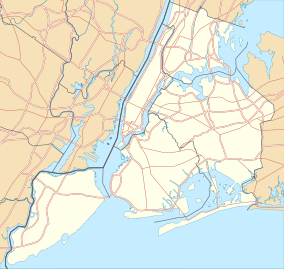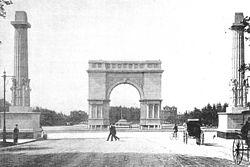Grand Army Plaza
 Grand Army Plaza viewed from the southeast, anchored by the Soldiers' and Sailors' Arch | |
 Location within New York City | |
| Location | Brooklyn, New York City, New York, United States |
|---|---|
| Coordinates | 40°40′27″N 73°58′13″W / 40.6743°N 73.9702°WCoordinates: 40°40′27″N 73°58′13″W / 40.6743°N 73.9702°W |
| Area | 14.26 acres (5.77 ha)[1] |
| Elevation | 131 ft (40 m)[2] |
Grand Army Plaza, originally known as Prospect Park Plaza, is a public plaza that comprises the northern corner and the main entrance[3] of Prospect Park in the New York City borough of Brooklyn. It consists of concentric oval rings arranged as streets, with the namesake Plaza Street comprising the outer ring. The inner ring is arranged as an ovoid roadway that carries the main street – Flatbush Avenue – with eight radial roads connecting Vanderbilt Avenue; Butler Place; two separate sections of Saint John's Place; Lincoln Place; Eastern Parkway; Prospect Park West; Union Street; and Berkeley Place. The only streets that penetrate to the inner ring are Flatbush Avenue, Vanderbilt Avenue, Prospect Park West, Eastern Parkway, and Union Street.
The plaza includes the Soldiers' and Sailors' Arch; the Bailey Fountain; the John F. Kennedy Monument; statues of Civil War generals Gouverneur K. Warren and Henry Warner Slocum; busts of notable Brooklyn citizens Alexander Skene and Henry W. Maxwell; and two 12-sided gazebos with "granite Tuscan columns, Guastavino vaulting, and bronze finials".[4]:668
History[]

Originally, the grounds of the Grand Army Plaza was a battleground of the Battle of Long Island, which was the first major battle of the American Revolutionary War to take place after the promulgation of the United States Declaration of Independence.
The 1861 plan for Prospect Park included an elliptical plaza at the intersection of Flatbush and Ninth avenues.[5] In 1867, the plaza was designed by Frederick Law Olmsted and Calvert Vaux as a grand entrance to the Park to separate the noisy city from the calm nature of the Park. Olmsted and Vaux's design included only the Fountain of the Golden Spray and the surrounding earth embankments covered in heavy plantings. The berms still shield the local apartment buildings and the main branch of the Brooklyn Public Library from the noisy traffic circle that has developed. By 1869 the Abraham Lincoln statue by Henry Kirke Brown[6] was north of the plaza fountain's stairs, and the statue was moved to the lower terrace of the park's Concert Grove in 1895.[5]
The original 1867 fountain was successively replaced by an 1873 lighted fountain, an 1897-1915 fountain for exhibitions, and the 1932 Bailey Fountain, renovated in 2006.

In 1895, three bronze sculpture groups were added to the 1892 Soldiers' and Sailors' Arch. When the New York City Subway's BMT Brighton Line (current B and Q trains) was being built in the 1920s, it was hoped that a station could be built almost directly under the site of the Brooklyn Central Library, but the $1 to 3 million cost was too much.[8][9]
In 1926, the plaza, previously known as Prospect Park Plaza, was renamed Grand Army Plaza to commemorate the sixtieth anniversary of the foundation of the Grand Army of the Republic, a fraternal organization composed of veterans of the Union Army and other military services who served in the American Civil War.[10]
In 1975, Grand Army Plaza became a National Historic Landmark.[11]
In 2008, a competition was held for designs to reorganize Grand Army Plaza to make it a more integral part of Prospect Park and more accessible to pedestrians.[12] At the same time, the New York City Department of Transportation (NYCDOT) made improvements in accessibility, putting sidewalks and planters in many of the striped areas. These improvements made it somewhat easier and safer for pedestrians and cyclists to cross from the park to the library and to the plaza. The changes made by the NYCDOT were modest in comparison to those in the designs in the competition, most of which called for the rerouting of some of the vast traffic flow.[13]

Current use[]
The area around the Arch forms the largest and busiest traffic circle in Brooklyn, being the convergence of Flatbush Avenue, Vanderbilt Avenue, Eastern Parkway, Prospect Park West, and Union Street. In 1927, Brooklyn's "Death-O-Meter", a sign admonishing drivers to "Slow Up" and displaying a continually updated tally of traffic accident deaths in the borough, was installed.[15]
A popular farmer's market, part of the Greenmarket program of GrowNYC is held on the plaza in front of Prospect Park every Saturday from 8 a.m. to 4 p.m..
The station is served by two New York City Subway stations and multiple bus routes. The Grand Army Plaza station (2 and 3 trains), built in 1920 on the IRT Eastern Parkway Line, is on the north end of the Plaza, while the Seventh Avenue station (B and Q trains) on the BMT Brighton Line is several blocks northwest.[16] The B67 and B69 buses stop at Union Street and 7th Avenue, two blocks north, while the B41 bus stops on Flatbush Avenue.[17]
A private funding campaign in 1999 was established to restore the monument. In 2018, keystones from the roof fell and protective barriers were placed around the monument to safeguard pedestrians. A full restoration of the arch and statue is set for 2021, sponsored by the City and Prospect Park Alliance.[18]
See also[]
References[]
- ^ "Bailey Fountain" (Historical Signs Project webpage for park marker). Grand Army Plaza. nycgovparks.org. Retrieved August 19, 2011.
- ^ "X_Value=-73.970156&Y_Value=40.674253". USGS Elevation Web Service Query. United States Geological Survey. Archived from the original on March 30, 2012. Retrieved June 24, 2011.
- ^ "Prospect Park". Brooklyn Daily Eagle. June 20, 1867. p. 2. Archived from the original on June 12, 2011. Retrieved February 5, 2019 – via Newspapers.com.
Entering at the main entrance or plaza, the visitor leaves on either side the mounds which flank the spot selected for the Fountain of the Gold Spray.
- ^ White, Norval; Willensky, Elliot (2000). AIA Guide to New York City (4th ed.). New York Chapter, American Institute of Architects; Crown Publishers/Random House. ISBN 0-8129-3106-8.
- ^ Jump up to: a b Lancaster, Clay (1972) [1967]. Prospect Park Handbook. New York: Long Island University Press. ISBN 0-913252-06-9.
On 20 October 1917 Brooklyn celebrated the 50th anniversary of the opening of Prospect Park, and the ceremony took place at the triumphal arch on Grand Army Plaza.
- ^ "Grand Army Plaze" Archived July 12, 2011, at the Wayback Machine on the Prospect Park Alliance website
- ^ "Grand Army Plaze: Henry W. Maxwell Memorial" on the NYC.gov website
- ^ New York Times, $7,120,000 Library Planned in Brooklyn, February 19, 1931, page 1 (subscription required)
- ^ Brooklyn Public Library, Annual Report, 1944-45, page 13
- ^ New York Times, Plaza in Brooklyn Dedicated to G.A.R., May 10, 1926, page 9
- ^ Ziegenfuss, Kathleen. "Grand Army Plaza". Hall of Shame. PPS.org. Archived from the original on July 16, 2011. Retrieved August 1, 2011.
In 1975, Grand Army Plaza became a National Historic Landmark
- ^ "Design Trust". Archived from the original on October 12, 2007. Retrieved June 17, 2009.
- ^ Grand Army Plaza enhancements
- ^ White, Norval; Willensky, Elliot & Leadon, Fran (2010). AIA Guide to New York City (5th ed.). New York: Oxford University Press. p. 669. ISBN 978-0-19538-386-7.
- ^ "Grand Army Plaza". New York City Parks. Retrieved May 10, 2015.
- ^ "Subway Map" (PDF). Metropolitan Transportation Authority. July 2021. Retrieved January 18, 2018.
- ^ "Brooklyn Bus Map" (PDF). Metropolitan Transportation Authority. October 2020. Retrieved December 1, 2020.
- ^ Verde, Ben. "City reveals designs for Grand Army Plaza restoration". Brooklyn Paper. Retrieved November 22, 2020.
External links[]
 Media related to Grand Army Plaza at Wikimedia Commons
Media related to Grand Army Plaza at Wikimedia Commons
- Grand Army Plaza
- Grand Army of the Republic buildings and structures
- National Historic Landmarks in New York City
- National Register of Historic Places in Brooklyn
- New York (state) in the American Civil War
- Park Slope
- Prospect Park (Brooklyn)
- Roundabouts and traffic circles in the United States
- Sculpture gardens, trails and parks in the United States
- Squares in Brooklyn





